I've long argued that private debt is a major problem for Australia and could be an even bigger concern if unemployment were to rise in 2016. There are two major ways that debt burdens could become a problem in 2016-17. Firstly, if unemployment rises and secondly, if interest rates rise. It's possible that if unemployment rises then the RBA will cut rates further, but interest payments may not be possible at all if you lose your job and have committed to a loan that is too big to handle. If this happens to enough people with loans then the rate of defaults will rise, but more importantly, the number of forced sales will increase leading to further falls in house prices and an end to the wealth effect that has helped Australians keep spending despite increased indebtedness and uncertainty.
The problem with these predictions is the relevant time frame. As Rudiger Dornbusch once said "The crisis takes a much longer time coming than you think, and then it happens much faster than you would have thought". Australia has thus far avoided a negative self-reinforcing spiral where higher unemployment leads to debt defaults, housing price falls and then higher unemployment and so on. Trying to avoid such cycles is the major reason why the Rudd government decided to fiscally support the economy during 2008 and 2009.
Leith van Onselon has written a great article over at MacroBusiness "Aussie Households Bombed on Debt". His article was based on a NATSEM report Buy Now, Pay Later: Household Debt in Australia.
The report reveals:
Foreign debt is also high and the major contributor has been the banks increasing their call on overseas funds.
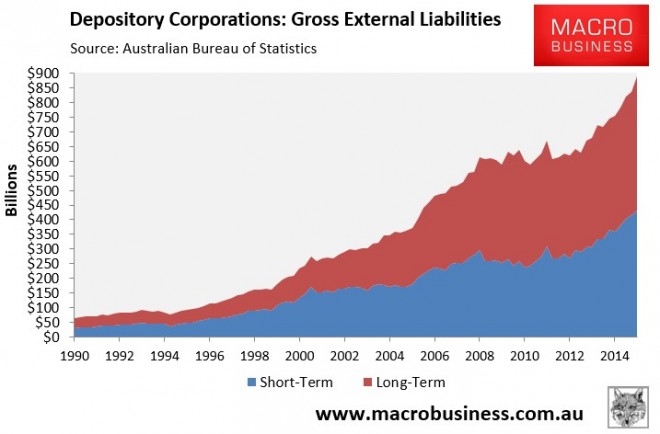
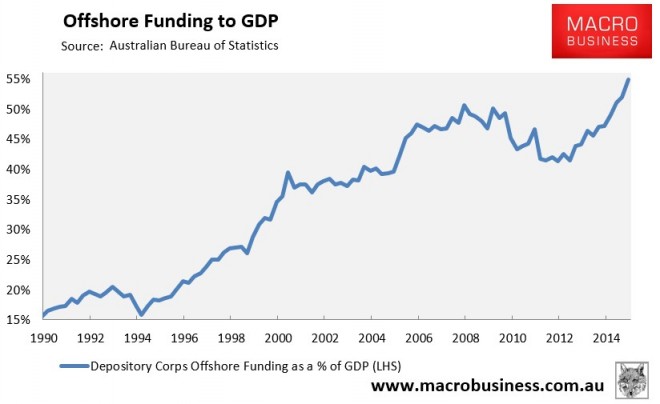
Household liabilities have been increasing at a greater rate than income - a simple function of increasing debt.
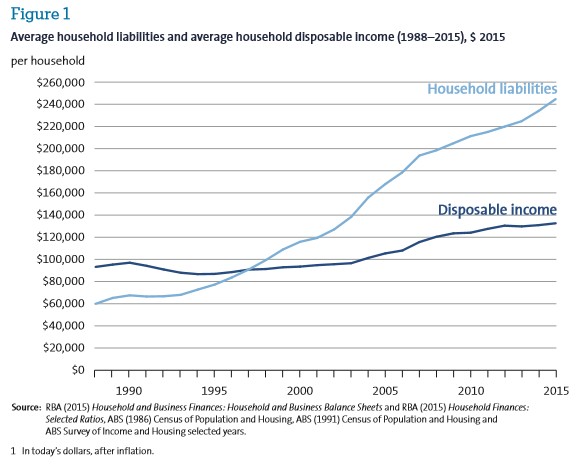
What really matters for households is the ability to service and pay down the debt. Low interest rates have helped enormously in recent years. The fact that the current level of rates is well below the average should be of some concern.
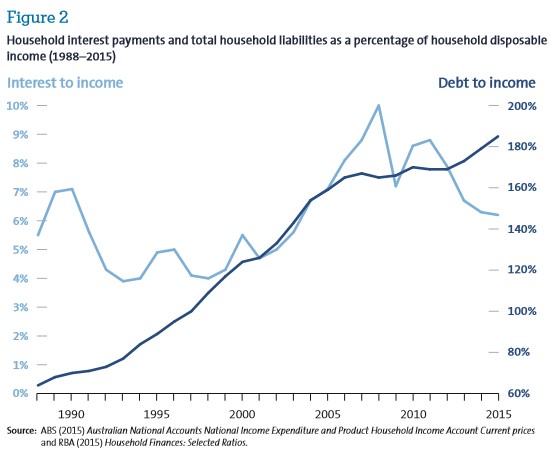
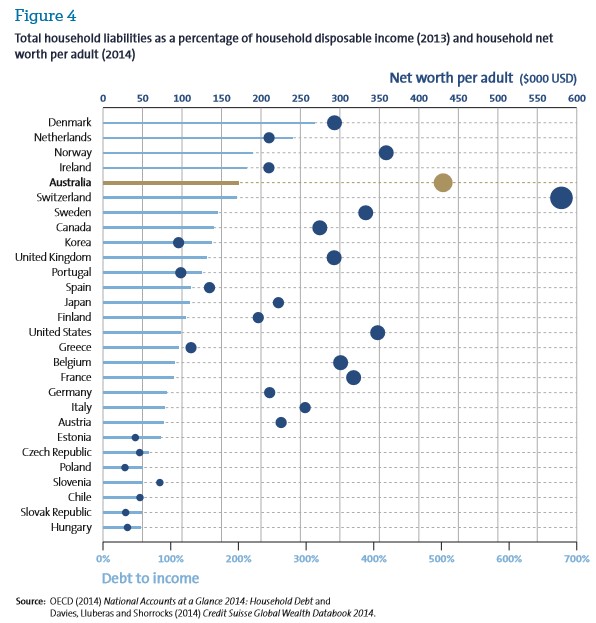
Australian asset holders have largely avoided a fall in housing prices. If prices were to fall, that gap between liabilities and income will seem larger as the assets side of the balance sheet loses value.
However, the really interesting data compares the debt situation for quintiles. This shows that the median ratio has increased for all income quintiles with the low income quintile showing the biggest increase.
Once again, however, low interest rates have made the servicing of debt easier, although the situation has worsened considerably for the lowest quintile.
NATSEM concludes with the following points:
The problem with these predictions is the relevant time frame. As Rudiger Dornbusch once said "The crisis takes a much longer time coming than you think, and then it happens much faster than you would have thought". Australia has thus far avoided a negative self-reinforcing spiral where higher unemployment leads to debt defaults, housing price falls and then higher unemployment and so on. Trying to avoid such cycles is the major reason why the Rudd government decided to fiscally support the economy during 2008 and 2009.
Leith van Onselon has written a great article over at MacroBusiness "Aussie Households Bombed on Debt". His article was based on a NATSEM report Buy Now, Pay Later: Household Debt in Australia.
The report reveals:
“Australian average household debt is now four times what it was 27 years ago, rising from $60,000 to $245,000, reflecting an annual growth rate of 5.3 per cent above inflation and leaving our income growth rate of 1.3 per cent trailing in its wake”
Foreign debt is also high and the major contributor has been the banks increasing their call on overseas funds.


Household liabilities have been increasing at a greater rate than income - a simple function of increasing debt.

What really matters for households is the ability to service and pay down the debt. Low interest rates have helped enormously in recent years. The fact that the current level of rates is well below the average should be of some concern.


Australian asset holders have largely avoided a fall in housing prices. If prices were to fall, that gap between liabilities and income will seem larger as the assets side of the balance sheet loses value.
However, the really interesting data compares the debt situation for quintiles. This shows that the median ratio has increased for all income quintiles with the low income quintile showing the biggest increase.
Once again, however, low interest rates have made the servicing of debt easier, although the situation has worsened considerably for the lowest quintile.
NATSEM concludes with the following points:
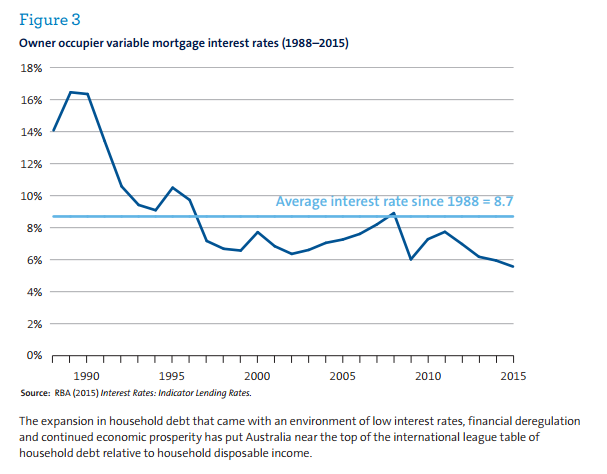



This is what we have to do. Australia needs to rise the GST by 2.5% and do a big biz tax like the carbon tax again.
ReplyDeleteThem 2 taxes will bring in $28 billion pa to do this to save the public money make jobs and boom the economy. It will also stop a rise in the cost of living "meaning" pay rises.
This saves the public $1k a year and small biz saved 2.
We can self fund departments for life by putting the money in banks safe interest funds, that pays for the cost of a publics cost of living. That means public living expanses / department. It would even pay for a rise in cost of the department each year. That's done buy putting that much money into it, that it even puts back in interest that pays for rising cost each year.
This is how it would work. It's for Adelaide Australia but would work the same in America.
Self Funding publics cost of lining....Adelaide's water bills.
Adelaide water company made about $350 million dollars last year.
Adelaide would need $12 - $14 billion dollars put into and safe interest fund, to self fund it for life. It works by using the interest made "$613 million dollars pa" to pay for it. It makes more interest than what it cost, so it puts back in the extra interest it makes and save it up "making interest" off the interest. We put back in $263 million dollars pa "or" $1.3 billion dollars making 6% pa in 5 years time. Every 5 years the department can have a rise $57 million dollar jump in cost, or $12 million a year. That means each year it will make $12 million dollars. It will rise by $12 million every year for life. That's $120 million dollar rise in 10 years. That's like a 33% rise every 10 years in the departments cost.
The gov still collect their taxes ad more each year.
In Adelaide that will save the public about $1k - $2+k pa. It will also save small biz big bucks 2. Farmers will be lol and the cost of fruit and veg will drop drastically...Maybe.
Each year they could save the public $1k a year. That $1k get's spent in the economy and the gov collects 30 - 40% tax of the $1k * 300 million people. The money small biz owner make will be spent to. So it's 30 - 40% of the $1k boost to the economy.
Part 2
ReplyDeleteThe public would pay a $1k tax a year. So after the second year they save $1k. After 7 years the public would have a spare $5 - $6k pa, and would pump $1.6 trillion dollars into the American economy. The gov will get 30 - 40% of that money spent in taxes. That hands them $600 billion dollars pa. Now add the % of money small biz makes as profits and spends from that $1 trillion left over. Clearly big biz will get a boost 2, so the 1 owner would spend much. It would have to be worked out the % small biz will make and big biz, to work the the extra boom to the economy and taxes paid.
It's not hard 2 do, and it would stop the cost / rising cost from rising. In fact it would let everyone have a wealthy life and happy 1 at that.
All country's around the world can do this and boom the economy make mass jobs and collect mass billion of dollars each year in their budgets. If it's not done now it will be to late, as big biz pay big taxes now. Really need to tax company's a small % of what they should be paying.
The good part of that, is the departments are self funded for life. It pays for rising cost so it's done for life. After 7 years and saving the public 45k - $6k. They would self fund the state hospitals and government departments cost for life after saving the public that much cash..
Not only can the public keep saving 1k a year. All state departments would be fully self funded with sate government getting part of the billions paid in tax each year.
Make the public wealthy. Makes the state government's rich and hands the fed's mass billion in knew funding. It also stops a rise in wages and the cost of living.
The thing is different departs can save the public more money. If you look at Australia you would see that the power company make $40 billion dollars pa. Too turn AU 100% power grid green it would cost $70 billion dollars. That means within 2 years of that money, they would make all the money back + $10 billion dollars.
Some departments can be looked at, to save the public more money first. Even doing projects with privet company's that are already digging up roads and laying pipe lines and so on.
You fist look at the cost to everyone. Self fund the department that dose 2 in 1 first.
Such a hard world we live in.
Lots of that money to self fund it can be handed to the banks to make interest and invest the money. That booms the country even more.
I would also force the public to put $30 a week extra into there super funds "because" they are saving $6k a years now. That will boost the economy in every way possible.